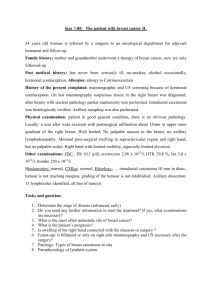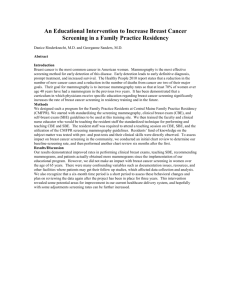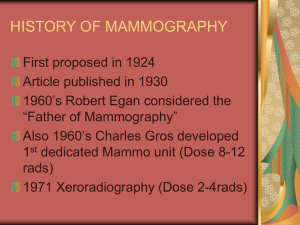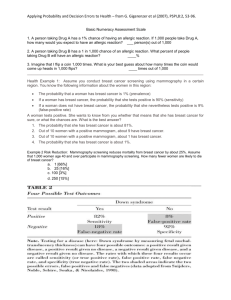Tribune relative risks overview, 3-15-02
advertisement
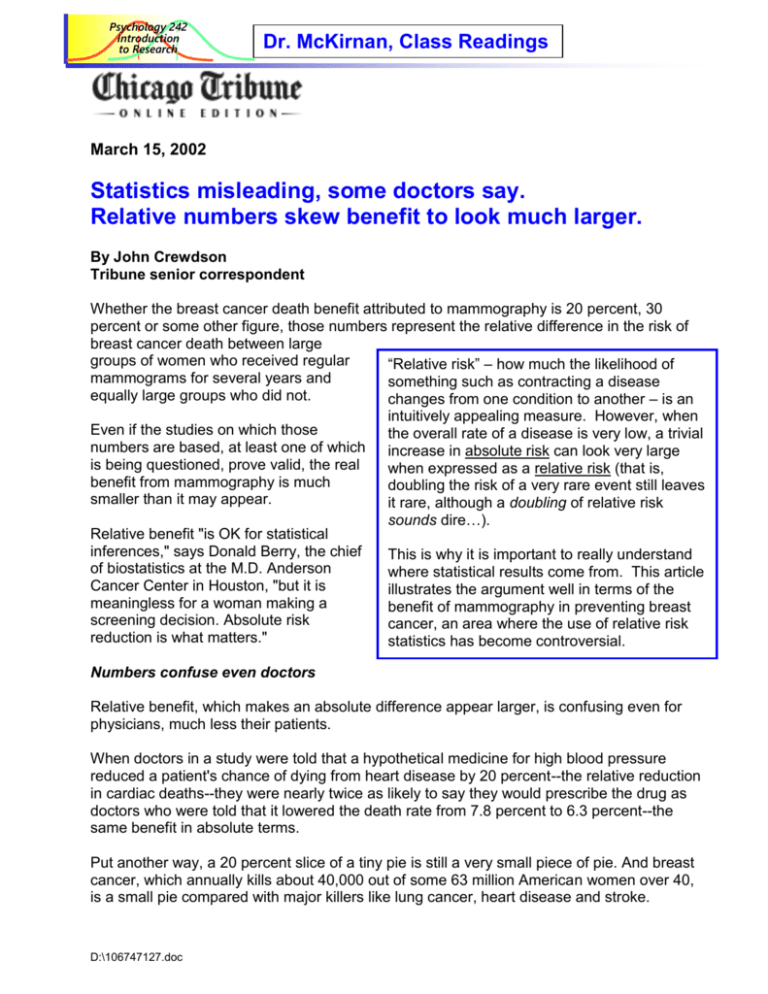
Psychology 242 Introduction to Research Dr. McKirnan, Class Readings March 15, 2002 Statistics misleading, some doctors say. Relative numbers skew benefit to look much larger. By John Crewdson Tribune senior correspondent Whether the breast cancer death benefit attributed to mammography is 20 percent, 30 percent or some other figure, those numbers represent the relative difference in the risk of breast cancer death between large groups of women who received regular “Relative risk” – how much the likelihood of mammograms for several years and something such as contracting a disease equally large groups who did not. changes from one condition to another – is an intuitively appealing measure. However, when Even if the studies on which those the overall rate of a disease is very low, a trivial numbers are based, at least one of which increase in absolute risk can look very large is being questioned, prove valid, the real when expressed as a relative risk (that is, benefit from mammography is much doubling the risk of a very rare event still leaves smaller than it may appear. it rare, although a doubling of relative risk sounds dire…). Relative benefit "is OK for statistical inferences," says Donald Berry, the chief This is why it is important to really understand of biostatistics at the M.D. Anderson where statistical results come from. This article Cancer Center in Houston, "but it is illustrates the argument well in terms of the meaningless for a woman making a benefit of mammography in preventing breast screening decision. Absolute risk cancer, an area where the use of relative risk reduction is what matters." statistics has become controversial. Numbers confuse even doctors Relative benefit, which makes an absolute difference appear larger, is confusing even for physicians, much less their patients. When doctors in a study were told that a hypothetical medicine for high blood pressure reduced a patient's chance of dying from heart disease by 20 percent--the relative reduction in cardiac deaths--they were nearly twice as likely to say they would prescribe the drug as doctors who were told that it lowered the death rate from 7.8 percent to 6.3 percent--the same benefit in absolute terms. Put another way, a 20 percent slice of a tiny pie is still a very small piece of pie. And breast cancer, which annually kills about 40,000 out of some 63 million American women over 40, is a small pie compared with major killers like lung cancer, heart disease and stroke. D:\106747127.doc McKirnan, Psychology 242, Week 9 reading. Interpreting relative risks data 2 The updated Swedish mammography trials to be reported Saturday in The Lancet, show a current relative death benefit of 20 percent among women who have mammograms. That's based on the determination that out of 129,750 women who were invited to begin having mammograms in the late 1970s and early 1980s, 511 died of breast cancer over the next 15 years--a death rate of 0.4 percent. In the comparison group of 117,260 women who were not invited, there were 584 breast cancer deaths over the same period--a death rate of 0.5 percent. That is, indeed, a 20 percent relative benefit in favor of mammography. But the absolute difference between the two groups after eight years of mammography is seven deaths a year in a female population of 250,000. Lars Werko, one of Sweden's best-known physicians, believes "it is useless to look at mortality" when calculating the benefits of mammography. "It is much better to look at how much the thing prolongs life," Werko says. "The question is, is it worth doing for such a short prolongation of life?" Werko notes that Finnish researchers attending a Swedish Cancer Society meeting last month reported that that country's mammography screening program had so far added between 10 and 12 days to the average woman's life. "It may be difficult to justify a screening program . . . on the basis of the mortality reduction only," the Finnish researchers concluded. According to Berry, the latest Swedish estimate of a 20 percent relative benefit means that the average woman in her 40s will gain a little less than three extra days of life. For women in their 50s the gain is a little more than three days. For women in their 60s, it is eight extra days. Another way of measuring the benefit of mammography, or any other medical intervention, is to calculate the number of procedures needed to save one life, an approach favored by Dr. Russell Harris, an internist and clinical epidemiologist at the University of North Carolina School of Medicine. Harris says that when he takes time to explain the benefit of mammography to his female patients in those terms, at least 1 in 10 chooses not to undergo the procedure. "I don't go at it saying mammography is a bad thing," he says. "It's just that relative risk reduction is not the way to go. It's necessary to understand the absolute risk. All I'm arguing is that I want them to know that number." Simplifying the decision Rather than tossing around percentages and odds ratios, Harris asks his female patients to imagine "a thousand people just like you. It's easier to understand that way." According to Harris's calculations, if none of 1,000 50_year_old women ever has a mammogram, 13 will die of breast cancer before they reach the age of 75--not a large number to begin with because breast cancer, despite the attention it currently is receiving, accounts for only about 2 percent of all deaths. Next, imagine that each of the 1,000 women has a mammogram every year for the next 10 106747127 McKirnan, Psychology 242, Week 9 reading. Interpreting relative risks data 3 years. Assuming the Swedish studies are valid, how will that affect the breast cancer death toll? Not by nearly as much as most women believe. Of the 13 women who would have died of breast cancer without mammograms, 10 still will die of breast cancer. The absolute benefit of mammography for women in their 50s, according to Harris, is three lives saved--or, to be more precise, three breast cancer deaths avoided--for every thousand women who have annual mammograms for 10 years, a total of 3,333 individual mammograms to prevent one death. If the 1,000 imaginary women in their 50s are replaced by 1,000 women in their 60s, the number of breast cancer deaths avoided increases to six. A less conservative estimate, by researchers at the University of California-San Francisco, suggests between 2,700 and 5,400 individual mammograms are required to avoid one death from breast cancer. Ideally, saving even one life at any cost is a worthy goal. In the real world of finite healthcare resources, the costs, both economic and psychic, must be carefully considered. "It is of course invidious to put a price on a woman's life," says British surgeon Dr. Michael Baum, "but one has to ask, could these large sums of money be redirected both for service and research in such a way that more women would benefit and fewer well women would be harmed?" But Dr. Steven Woolf, a professor of family practice at Virginia Commonwealth University, notes that "the rest of us are interested in absolute benefits not because of monetary concerns, but because of worries about the harms of interventions. The cost is a side issue if the intervention causes more harm than good." A recent study in The Lancet concluded that for every 10,000 mammograms given to apparently healthy women, doctors will order an average of 647 "diagnostic" mammograms, a more painstaking, and expensive, procedure to re-examine something that appeared suspicious the first time around. More tests follow procedure Determining which women have cancer, The Lancet said, also will require 358 breast examinations by ultrasound; 104 "aspiration" biopsies, in which a long needle is used to remove fluid and cells from the area of the breast with the apparent abnormality; 209 surgical biopsies, in which part of the breast containing the abnormality is surgically removed; and 500 additional doctor's office visits for physical examinations or surgical consultations. In the end, only about 25 of the 1,000 women will have breast cancer, because the great majority of the "abnormal" mammograms will prove to be false positives. But the mammograms and the procedures they spawn will have cost the health-care system about $350,000 for each breast cancer death avoided, not counting the costs of treating those women who actually do have cancer. Copyright © 2002, Chicago Tribune 106747127

